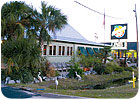
Even though it’s essentially one room, each zone of the newly rebuilt Southside Café now has its own strategically placed sheet metal return air diffusers in the ceiling that prevent infiltration between zones, which has helped attract both smokers and non-smokers.
Cigarette smoke control has been a major economic issue for restaurants and bars in the last five years. However it’s no longer an issue for the Southside Café. Thanks to a mechanical contractor’s D-B air distribution design at this popular spot on the northern edge of Lake Ponchartrain in the New Orleans suburb of Slidell, LA, patrons are now breathing easy in the Big Easy.
General manager Christian Legrand looked to John William “Bill” Logiudice, president of Year Round Air Conditioning & Co., Inc., and Year Round’s supervisory staff of Steve King and Ray Swain, for creative IAQ ideas. After the Southside Café burned down to the ground while closed for post-Katrina Hurricane repairs, Legrand had the rare opportunity to start from scratch and gave the team creative freedom to D-B an innovative system.
RAISING THE ANCHOR
Year Round anchored the design around American Standard heating/cooling package units and fabric ductwork from DuctSox. “We’ve noticed a definite air comfort improvement and an unbelievable air movement in this design versus a system with registers that blow drafts on customers,” said Legrand. “Because of limited seating, one customer reluctantly sat at a table five ft away from smokers at the bar and made a comment to me personally that cigarette smoke was completely unnoticed.”Although the bar and restaurant areas are basically one large room, Year Round’s design strategy divides the building into three ventilation zones - the 1,500-sq-ft main restaurant area supplied by an American Standard 15-ton, 6,000-cfm packaged rooftop unit with gas-fired heating; the 1,000-sq-ft bar supplied by a 10-ton, 4,000-cfm packaged rooftop unit with gas-fired heating; and a 575-sq-ft designated non-smoking area uses a 5-ton, 2,000-cfm DX split system with electric heating. Year Round didn’t specify a rooftop style unit for the non-smoking area because it’s located in the front of the restaurant where exterior aesthetics and a small footprint are important issues.
Each zone has its own strategically placed sheet metal return air diffusers in the ceiling that prevent infiltration between zones. Combined with the fabric duct’s linear vents, which deliver an even air distribution to all corners of the establishment, the air distribution supplies and returns work synergistically to eliminate smoke and air stratification.
“It’s the linear diffusion, proper duct location, and the fact there are no drafts that creates great IAQ and this project illustrates that,” said Logiudice. “I’ve used linear diffusers in spiral metal duct, but it drastically increases the price of the project, plus you can’t have them run the entire length or else the duct loses structural integrity.”
ADDED IAQ TOOLS
Adding to the IAQ are Lumalier UV irradiation lamps installed into the packaged units to kill odor-producing bacteria spores as the units re-circulate. Another odor eater is the anti-microbial agent built into DuctSox’s Sedona Xm, a fabric that minimizes surface bacterial growth.Aside from better airflow, Logiudice said the choice of fabric duct instead of a spiral metal duct alternative saved the Southside Café approximately 35% and 10% on HVAC duct labor and material costs, respectively. “We already knew how to set up the suspension cable from previous projects, so it went up probably about 50% faster than metal duct would have,” said King. “Once the cable was installed, the actual hanging of ductwork took just a day.”
The fabric duct also lends an aesthetic appeal to the facility’s open architectural truss ceiling, which purposely resembles a military structure in order to display military memorabilia.
DUAL-DUCT EXHAUST
Installing new energy-efficient HVAC equipment and dividing it into zones allowed Year Round to pressurize the new restaurant more effectively than its predecessor’s negative pressure, which allowed outside cold and hot air to infiltrate. Inducting 15-cfm/person outside air for a 150-person occupancy and exhausting less than that amount established a positive pressure.Additionally, Year Round ensured the preferred negative pressure in the cooking area by specifying the kitchen’s own 10-ton DX unit and a dual-duct exhaust hood. “Without a dual-duct system, we would be drawing air conditioning from the dining and bar area into the kitchen, therefore the packaged units for the patrons would have to work harder and eventually start bringing air in from the doors and windows to accommodate,” Legrand said.
While many restaurants nationwide want to attract both smokers and non-smokers in an attempt to widen their customer base, the Southside Café appears to have found the solution to pleasing both factions.
